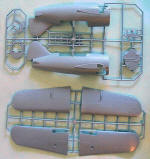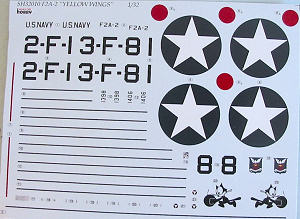
| KIT: | Special Hobby 1/32 F2A-2 Buffalo |
| KIT #: | ? |
| PRICE: | $54.00 MSRP |
| DECALS: | Two options |
| REVIEWER: | Tom Cleaver |
| NOTES: |

| HISTORY |
By the late 1930s, everyone in U.S. Naval Aviation was aware that the fighting biplane was obsolete, though there were those who believed it would be impossible to marry the high performance of a monoplane with the requirements of carrier operations. In late 1937, the Bureau of Aeronautics put forward a set of requirements for an F3F replacement that - like those which resulted in the SB2U-1 - did not necessarily call for a monoplane.
In fact, Grumman was asked to submit a biplane design, the XF4F-1. Grumman did so grudgingly, but soon managed to convince the powers-that-be that with a little detail refinement to the F3F-2 and a higher-powered R-985, the requested performance for the XF4F-1 could be bettered. This resulted in Grumman delivering the last Navy biplane fighter, the F3F-3, and allowed the company to design and submit a monoplane, the XF4F-2.
How the U.S. Navy managed as a result of the competition to not only allow Brewster - a company that had begun by making buggies a hundred years earlier and had never yet produced a successful aircraft design - to enter a design, but chose that over the submission of the premier Naval aircraft manufacturer is one of those anomalies of aviation history that makes things interesting. Nevertheless, the XF4F-2 was beaten by the XF2A-1, and Brewster Aircraft Company received the contract to take the Navy into the next generation of combat aircraft.
A more unlikely source would be hard to imagine. The company had no understanding of how to mass-produce an airplane. The two-story factory did not have elevators, and the completed fuselages, which were hand-assembled on the second floor, were lowered by a hay baler type of winch to the lower floor. Once there and completed, there was no airport to test the airplanes, which had to be towed several miles to the Buffalo airport.
Needless to say, Brewster was behind schedule by the time they delivered the first production F2A-1 in the late summer of 1939 and never did catch up throughout the entire production run of the F2A series.
VF-3, the squadron chosen to be the first to equip with the new fighter, had only received six of them when the entire rest of the 54-aircraft production run for the F2A-1 was diverted to Finland with the outbreak of the Winter War in November 1939. The squadron flew on with six F2A-1s and 12 F3F-1s until the summer of 1940, when they were able to re-equip with the F2A-2, which also allowed VF-2 - The Flying Chiefs - to replace their thoroughly-antiquated Grumman F2F-1s.
The F2A-2 was likely the best version overall in terms of performance, and was also produced for export as the Model 339, seeing service with the RAF at Singapore, and with the Dutch in the Netherlands East Indies. The Model 339 was thoroughly outperformed by its opponents, though it might have seen better service had the RAF and the Dutch used tactics similar to those developed by the American Volunteer Group, which would have kept pilots from attempting to “dogfight” in an airplane too heavy and too underpowered for that kind of fighting.
Some of the remaining F2A-1s were returned to the factory to be modified to F2A-2 standards in late 1940, but at least one survived as an F2A-1 until the summer of 1942, when it crashed at NAS Miami where it was being used as an advanced trainer. The F2A-2s ended their days as advanced fighter trainers at NAS Miami, where the aircraft’s weak landing gear resulted in all of them being eventually written off.
| THE KIT |

 (I've
only shown a representative sprue and the resin bits. Ed.) Prior to the
release of this kit, the only 1/32 F2A was a resin “garage kit” originally
created by Jerry Rutman, which has been unavailable for several years and would
be in any case completely outdated by this release from Special Hobby. It is
interesting to note that the MPM Website shows the F2A-1/Model 329 “Finnish
Buffalo” and Model 339E “RAF Buffalo” as future releases, so the entire series
will be available in this larger scale in the foreseeable future.
(I've
only shown a representative sprue and the resin bits. Ed.) Prior to the
release of this kit, the only 1/32 F2A was a resin “garage kit” originally
created by Jerry Rutman, which has been unavailable for several years and would
be in any case completely outdated by this release from Special Hobby. It is
interesting to note that the MPM Website shows the F2A-1/Model 329 “Finnish
Buffalo” and Model 339E “RAF Buffalo” as future releases, so the entire series
will be available in this larger scale in the foreseeable future.
On opening the box, it is easy to answer the question “Who’s your daddy?” This kit is basically the 1/48 Classic Airframes kit - which was designed and produced by MPM - pantographed up to 1/32 scale, with almost all the resin parts of the earlier kit now produced in injection plastic.
The kit includes the separate windscreen and different sliding canopy for the other Buffalo versions. The clear plastic of these parts is very clear, and thin enough to pose the sliding canopy open. I found it interesting that, in this large scale, the canopy is finally produced as it really was on the full-scale airplane, with a different cross section fore and aft, and with the rear fixed canopy more curved in cross section than it has been done as in the smaller scales.
As is now usual with the Special Hobby/Azure 1/32 kits, the cockpit is now done in injection plastic, but will be undoubtedly released in the future as a resin “hi-tech” release. Not to panic. All these parts are fine, and photoetch detail parts for the instrument panels and seat belts is provided.
Test-fitting of parts shows that the kit fits at least as well as the 1/48
Classic Airframes kit did, though I cannot at this point about whether it
carries on certain assembly difficulties that the Classic Airframes kits had
(but I will only be surprised if it doesn’t). The main problem with earlier
kits in this series (the D.520, the M.S.406, the P-36/Hawk 7 5)
was that they were all low-wing monoplanes with a one-piece lower wing that led
to difficulties in getting the proper dihedral in the wing with poor fit of the
upper wing parts to the fuselage. With the F2A-2 having a mid wing, and with
the wings separate, this is not a problem. The kit provides spars that insure
the wings will end up with the same dihedral and a good anchor for attachment to
the fuselage.
5)
was that they were all low-wing monoplanes with a one-piece lower wing that led
to difficulties in getting the proper dihedral in the wing with poor fit of the
upper wing parts to the fuselage. With the F2A-2 having a mid wing, and with
the wings separate, this is not a problem. The kit provides spars that insure
the wings will end up with the same dihedral and a good anchor for attachment to
the fuselage.
The decals are acceptable. They provide markings for the Squadron Commander’s airplane of VF-2, and for the Number 8 airplane of VF-3. The VF-3 “Felix the Cat” insignia is wrong because it does not provide white for the facial detail of Felix. Fortunately, Yellow Wings Decals is producing a sheet of decals for this kit that will allow a modeler to make any F2A-2, with the correct squadron markings. I suggest you pick that sheet up, since it will be available by the end of October.
| CONCLUSIONS |
This kit has been amazingly popular since its initial release at the 2006 IPMS-USA National Convention this past July, with the first run being sold out at Hannant’s by late August, and a second run that was delivered there in late September having now also disappeared. The three that came in to my local hobby shop in early September were gone by the end of that weekend. So several thousand of these kits are out there.
For those who model U.S. Navy fighters, the F2A-2 is a historically-significant airplane, and this large scale kit looks like it can be turned into an accurate model with requisite effort. Modelers with several limited-run kits under their belt who are willing to take their time during assembly will end up with an interesting addition to their “Golden Wings” collection.
Review kit courtesy of Hannant’s. http://www.hannants.co.uk/
If you would like your product reviewed fairly and quickly by a site that has over 325,000 visitors a month, please contact me or see other details in the Note to Contributors.